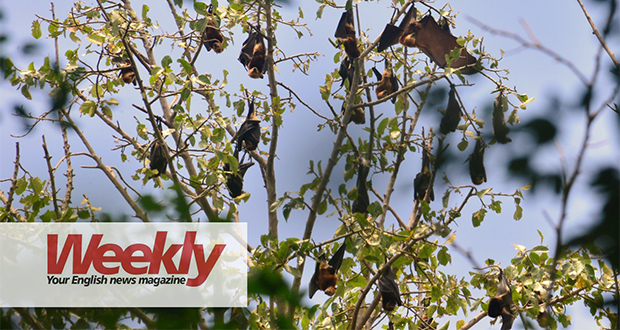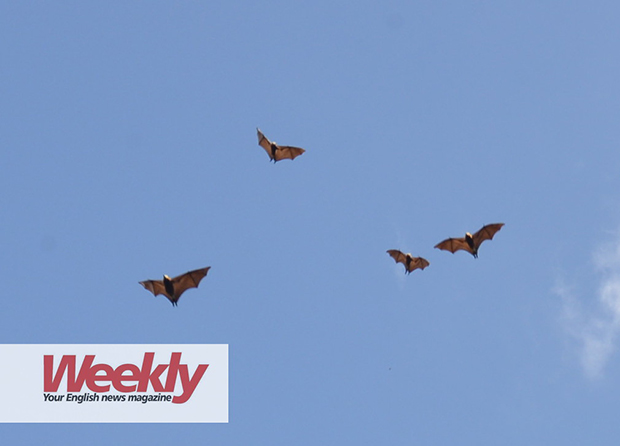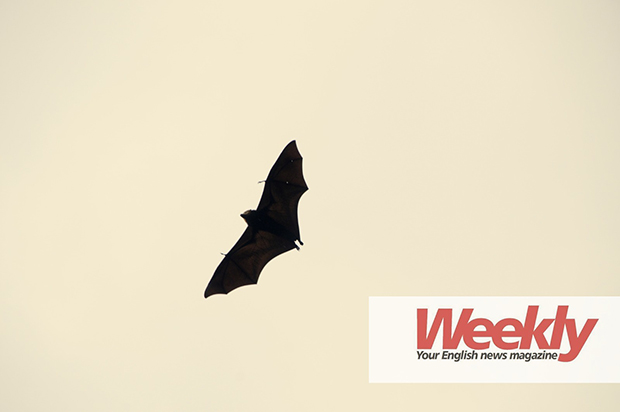Publicité
Is bad science pushing the Mauritian fruit bat to the brink?
Par
Partager cet article
Is bad science pushing the Mauritian fruit bat to the brink?


This article was published in Weekly No. 341 of 21 March 2019.
The Mauritian fruit bat, also known as the Mauritian flying fox, has been in the government’s crosshairs for a number of years now. Pushed by fruit growers, the government has conducted three episodes of cullings in recent years, outraging conservationists to the point that the fight has now made it to the courts. Is bad science by the government actually pushing Mauritius’ last surviving bat species to the brink?
The Mauritian fruit bat (or Mauritian flying fox, Pteropus niger) is the last remaining species of native bats in the country. In recent years, the government has declared war on the bats, pushed by local fruit exporters who see the bat as a pest. And so starting in 2015, the government carried out three separate culling exercises against the bats. The first, according to Minister of Agro-industry, Mahen Seeruttun, took place in 2015 and led to the killing of 30,938 bats. That was followed by a second culling at the end of December 2016 when 7,360 bats were killed and in 2018 another culling took place targeting 13,000 bats. In all then, since 2015 the government culled at least 38,000 bats (the number of animals killed in 2018 has not been made public yet). This has prompted outrage from local and international conservation groups who now have brought a lawsuit against the government (hearings are due to start in May 9 this year) for violating the Animal Welfare Act.
To start with, the tug of war between the government and conservation groups is a complex issue. Since 2002, small-scale fruit planters began exporting some of the fruit grown in Mauritius. Since then, fruit exports have grown. Out of the 1,000-4,000 tonnes of litchees produced in the country, between 200 and 300 tonnes are exported to countries like France and Germany, netting in between Rs45 and Rs50 million in export revenue. But as the importance of fruit has grown, so has the problem with the bats. From as early as 2006, fruit planters have called for culls, but previous governments have largely shied away from that option (there was only one very limited cull in 2006) since the International Union for Conservation of Nature (IUCN) that tracks endangered species around the globe listed the Mauritian fruit bat as an endangered species and local legislation did not allow culling a protected species. That changed in 2015.
“In other words, the law now gave the government the greenlight to cull the bats whether or not the IUCN put it back on the ‘endangered’ species list.”
At the root of the ire of the conservation groups is the manner in which the government seemed to play a sleight of hand on this issue. On the one hand, the government lobbied with the IUCN to downgrade the status of the bat from endangered to vulnerable, citing growing bat numbers. The IUCN eventually gave in, but with a proviso that they would immediately look into changing the conservation status of the bat if the government decided to embark on a culling programme. The government then decided to go above these provisos by pushing through legislation essentially to allow precisely that. Previously, bat culling was prohibited under the Wildlife and National Parks Act 1993. But after the IUCN included the proviso, the government came up with the Native Terrestrial Biodiversity and National Parks Act 2015 that called for a special technical committee to decide whether to allow a culling programme regardless of whether the animal was endangered or not. In other words, the law now gave the government the greenlight to cull the bats whether or not the IUCN put it back on the ‘endangered’ species list. That is why the case lodged against the government is on the grounds of animal cruelty as opposed to killing an endangered species.

One major issue with the government’s culling is the scientific assumptions underpinning it. In other words, the government, planters and conservationists by no means agree on how many bats are actually left in the country. In 2015, at the time of the cull, planters estimated that there were between 500,000 and one million. The IUCN put that number at between 50,000 and 55,000. The government, on the other hand, put the number at 100,000. In October 2015, shortly before the culling began, Seeruttun said that “as we have not been visited by strong cyclones (a natural population control mechanism that kills off large numbers of bats –ed.) during the past decade, the bat population is continuing to grow and may have reached a pest level” (sic). It was this government estimate of the bat population that led to the approval of the culling, which former Environment Minister Raj Dayal colourfully dubbed ‘Operation C-Bat’. Based on these bat population numbers, the government justified the culling by estimating that bats caused Rs180 million worth of damage to fruit crops each year, a figure floated at a seminar organised by Seeruttun’s ministry in May 2018.
“If the conservationists are right, the government has killed at least 76 percent of an endangered species population!”
The problem is that the government’s numbers are not supported by any other scientific estimate and conservation groups have slammed the numbers as inflated given the unscientific way in which the Mauritian government is counting the bats. Put simply, the way the government counts bats is by going into the forest and shaking trees getting the bats to fly. As they do they are counted as officials comb the forest. The problem is that bats go from one place to another and are counted each time they fly again. The World Wildlife Foundation (WWF) has criticized this method as leading to “double counting” and “inflated estimates”. Put simply, because of the way the government counts its bats, their estimates could well be at least double what the actual number is. The Mauritian Wildlife Foundation (MWF) for its part puts the number of bats at 50,000. This is no small quibble since if the government numbers are correct, they have culled at least 38 percent of the total bat population. But if the conservationists are right, the government has killed at least 76 percent of an endangered species population! No wonder local and international conservation groups ranging from the MWF, the WWF and the IUCN are opposed to the culling. In fact in November 2015, WWF’s African Regional Director Frederick Kumah argued, “The people of Mauritius do not support this cull and nor do the world's scientists and conservationists. There is no acceptable reason to continue with this destruction.”

But the bat-killing did happen. And the results were a little problematic to say the least. Because the government and planters inflated the bat numbers, so too did they exaggerate the actual damage that bats caused. And so after two rounds of culling, did the fruit crop increase? Let us take Litchees for example. On average, 5,000 tonnes of litchees are grown annually but, following two rounds of bat-culling, the Food and Agricultural Research and Extension Institute (FAREI) said that the 2017 crop was just 900 tonnes. There were fewer bats, but surprisingly fewer litchees too. Reacting to this, Seeruttun had to admit in parliament in October 2017 that the crop loss “had nothing to do with bats”. Kreepalloo Sunghoon, of the Small Planters’ Association, for his part, argued that climate change was a possible culprit and hoped that “the FAREI would conduct a scientific study of the cause of this drop in production”. Well, FAREI did not come up with anything, and the government went ahead and approved another bat-cull in 2018 anyway. The bat apparently was made to take the blame for climate change and other fruit eating species such as birds, macaques and rats. In fact, a research paper published in the Journal for Nature Conservation in February 2019 found that historically, bats and birds accounted for only 9.3 percent of litchee losses, the bulk of it (29.3 percent) was due to poor growing methods such as allowing the fruit to simply spoil by not harvesting it on time, or allowing it to drop. Nevertheless, in the face of contrary evidence, the government once again went on the rampage against the bats, leading the IUCN to once again change its status from ‘vulnerable’ back to ‘endangered’.
The issue is that all this does not just stop at the bats, but will have knock-on effects. The Mauritian flying fox is crucial for the survival of whatever remains of Mauritius’ natural forest (covering a mere 1.5 percent of land area at last count) and play a key role in pollinating at least 18 different species of native plants. By culling bats in this haphazard way, all the government might end up doing is reducing their numbers just low enough that the next cyclone devastates their population, or their numbers go so low that they get trapped in a genetic bottleneck and become susceptible to disease (as the Pink Pigeon is now). The ultimate danger is that without its own means of scientifically – really scientifically – knowing how many bats there actually are, the government may be needlessly pushing it to the brink of extinction.
For more views and in-depth analysis of current issues, Weekly magazine (Price: Rs 25) or subscribe to Weekly for Rs110 a month. (Free delivery to your doorstep). Email us on: weekly@lexpress.mu
Publicité
Publicité
Les plus récents






